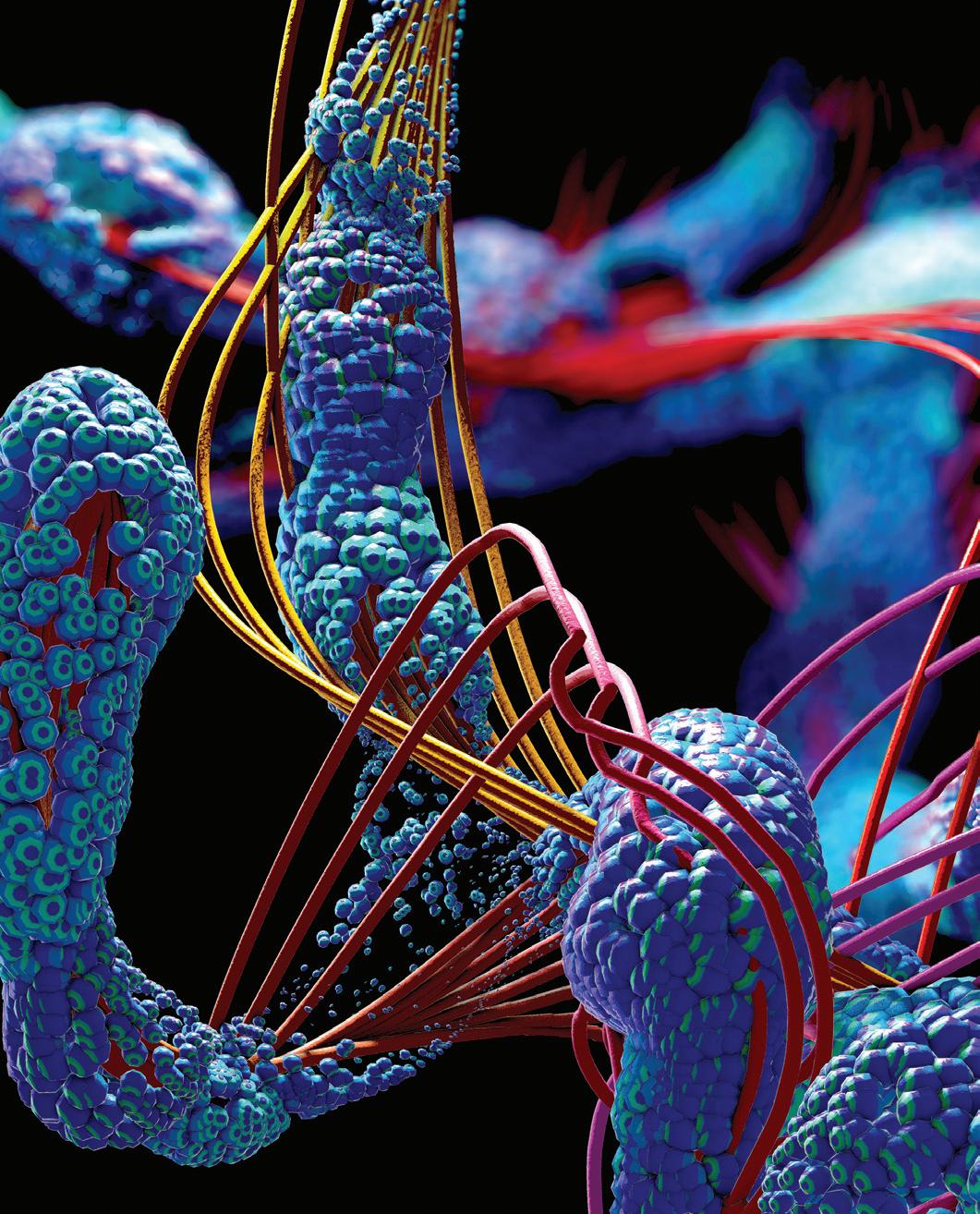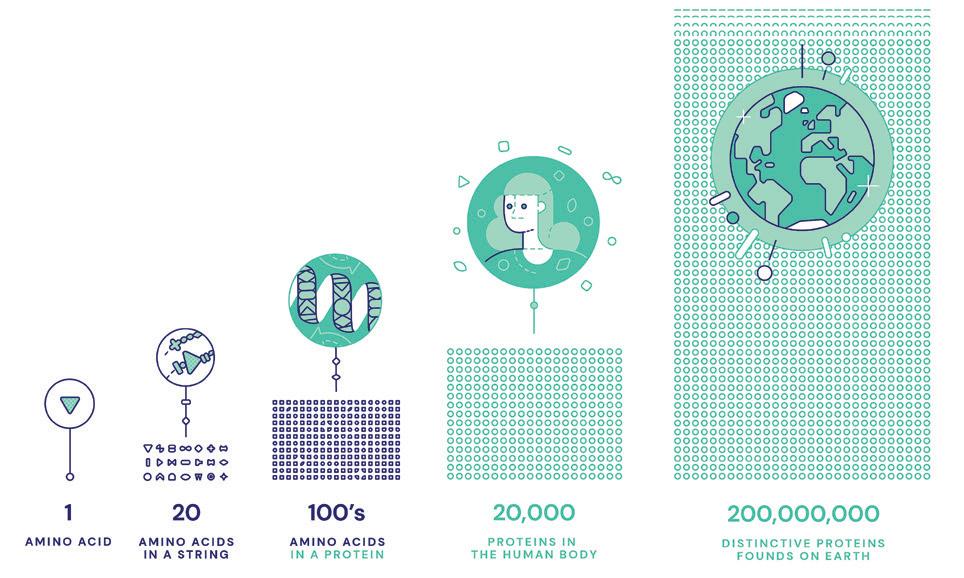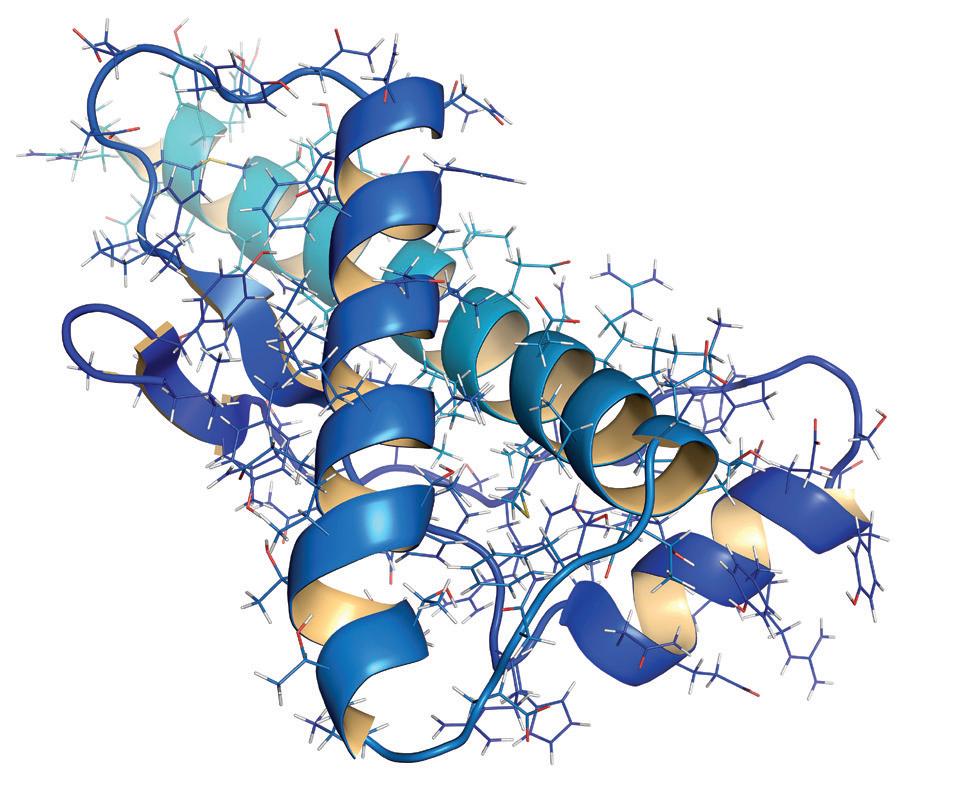
10 minute read
holy grail Unveiling the
The year 2022 will go down in history as one of the most crucial of all time. Not only have we seen the most reckless grab for power by Russian president Vladimir Putin that we have seen since Hitler, and the death of a woman who was the epitome of the anthesis of what Putin represents, but last August came the announcement from DeepMind of a step forward in biology the like of which the world has not seen since the mystery of DNA was unravelled.
DeepMind (www.deepmind.com) is a British artificial intelligence (AI) company which was formed in 2010 and acquired by Google in 2014. It comprises a team of scientists, engineers, ethicists and more who are “committed to solving intelligence to advance science and benefit humanity.” You may have heard about their earlier accomplishments using AI to play chess, but late last year they announced a breakthrough which was effectively the equivalent of unveiling the holy grail of biological science.
After years of research, they have developed an AI program called AlphaFold which provides the folding sequences and patterns of the 200 million proteins known to science. AlphaFold can accurately predict 3D models of protein structures and as such is accelerating research in nearly every field of biology.
Why is this such a big deal? To put things into perspective, you have to appreciate how painstakingly long it took to unravel the structure of DNA. The conventional pathways of crystallography, the almost 10 years of laboratory slavery by British chemist Rosalind Franklin, set the stage for two ‘almost’ cowboys in the scientific sense, Watson and Crick, to see the inspiration in Rosalind’s images and to work out the patterns of repeating amino acids which gave the key to the structure of DNA – at that time another version of the holy grail of science.
The great predictions that DNA studies would unravel the key to all human diseases and see an explosion of medical cures have been slow arriving. Why? The big stumbling block was that what DNA does is give the templates and tools for putting together the sequences of amino acids that give us proteins. It does this indirectly through RNA which controls the enzyme proteins which are the key to the building block proteins and systems which produce functioning organisms.
Even the massive Human Genome project which set about uncovering every gene (or DNA sequences) in man took more than 10 years to reach its goal. It did get quicker and quicker along the way, bringing the costs down from hundreds of thousands of dollars to merely a few thousand. It also provided the springboard for developing new techniques, many of which are in daily use in routine lab techniques all over the world and in many industries.
That the flowering of medicine flowing from DNA sequencing got stuck was caused by the lack of advancement in working out how to manipulate enzymes. It has long been known that enzymes, which are proteins, work like keys. They have specific shapes, which are dependent on the way their structural proteins fold, that give them their unique properties. We can easily represent the components of a protein and the bonds which hold their structural elements in place in a linear diagram on paper, but we can’t easily predict exactly how they will fold. Indeed, two different enzymes may have the same set of amino acids on paper, but because they fold differently they will have totally different effects on what is produced. These are the very bare bones of the processes and there are a multitude of variations that depend on quantum properties of constituent particles like electron spin that influence outcomes. We won’t try to go there or else we’ll all end up in a spin!
So, what does all this mean for us in practice? It means that it will be much quicker and much cheaper for structural chemists to create and explore new chemical structures in the search for biologically-reactive molecules. If you know the structural shape of proteins then you can design a key to open the protein, be it viral, bacterial or fungal, or an antidote vaccine or drug treatment.
This is a mind-blowing advance. It changes the whole game, especially in pharmacology and immunology. For pharmacology read veterinary and agricultural chemicals as well as human. It cuts the time taken for a new product development from tens of years to potentially 5-10 years from design/discovery to market.
A discovery of this scale cuts not only years of development but potentially billions of dollars from the costs of the chemicals you will use in the future. I am supremely jealous because this great discovery has come at a time in my career when I probably won’t see its full development, let alone take a part in it. This is not going to be a page turner for the small third-tier chemical companies that by and large service the turf industry and you probably won’t see the benefits for a minimum of five years.
What does it mean for other areas of biology such as plant breeding? Plant breeding has seen incredible advances in the last 50 years, firstly with the discovery of gene shears pioneered by Dr Jim Peacock who was a doctoral student at Sydney University in my time there. He later became chief of CSIRO Biology. This great advance was later eclipsed by the development of CRISPR which is a technique that removes the fear of introducing foreign genes into plants (GMOs).
It mainly uses the genes already in the plant to increase their number and effectiveness. A good example of this is what the University of Cambridge achieved in its wheat breeding program. It increased the number of genes for flower expression by three. This gave a 30 per cent increase in grain yield without essentially changing the plant.
The impact of this protein folding technology is going to change the whole way we approach disease diagnosis, whether human, animal or plant. There will be a huge explosion in ‘template matching’ technology where a simple blood or plant sap extract can be put on a template and the proteins in it matched to known disease patterns. This will be done with a very high degree of accuracy. While the new technology is not currently 100 per cent perfect in its predictions, it is well above the 90 per cent mark which is a lot better than we currently achieve with our present techniques.
We can also expect that we will see very different approaches to herbicide and other pesticide developments. In the world of herbicides, when I started in turfgrass science over 50 years ago we did not see any emphasis on the mode of action in the physiology of the plant. That was something you really had to go looking for. Today when you see how herbicides are classified, it is all related to their mode of action and the same applies to the various insecticide groups.
It is going to be much more common for the formulators looking into the development of chemicals that may have properties that shut down more than one metabolic system. This alone will lift the bar on the development of herbicide resistance. It is quite amazing that after over 70 years of use, the hormone herbicide group which includes 2,4-D, 245T, MCPA, MCPP and Dicamba still show very little resistance. This is because they work on the most fundamental systems of plant growth.
While a much better understanding of the lock and key systems of enzyme function will come from this latest breakthrough, it is not going to change the fundamentals of plant metabolic systems and the essential nature of the energy transfer between ADP (Adenosine di-phosphate) and ATP (Adenosine triphosphate). It is also not going to change the fundamentals of the need for understanding how the timing of herbicide applications affect the outcomes.
In another new announcement from Stephen Long at the University of Illinois Urbana-Champaign, there have been some considerable advances in upgrading the efficiency of photosynthesis. While this work has been done primarily with soy beans, they are also working on extending it to rice. While previous work of this kind has been done in tobacco plants, this is a first for a food crop.
Scientists have long been aware that in terms of energy capture, plants are relatively inefficient, capturing as little as 30 per cent of the incident energy they receive. Especially at high light levels, chlorophyll becomes over excited and has a high level of fluorescence which in turn produces oxygen radicles which damage the surrounding tissues. Plants have a natural protective mechanism against this called quenching. Most plants turn quenching on and off rather slowly. This is especially important in plants under shaded conditions, which don’t want to lose any of the energy they get.
Long and his team have looked at genetic manipulation as a way of controlling the speed of the quenching reaction. By using CRISPR to add extra copies of the genes involved in quenching, they increase the levels of the encoded proteins and speed up the rate of transition. This may be a very important key to improving the shade performance of turfgrasses in the future.
The big lesson here is that sometimes what seem to be huge advances in turfgrass science don’t always come to fruition in the long-term. I never get tired of telling the story of seeing the magical lack of disease in trial plots at Michigan University in 1973 in a herbicide trial run by Joe Vargas. The bentgrass had been given genes for resistance to a herbicide so as to be able to use the herbicide to selectively remove Poa annua from bentgrass. It did this very well with the added bonus of the plots being disease free from pythium, phytophthora and rhizoctonia.
Just why this work went nowhere is a mystery. Since it was seed industry funded there may have been problems with seed production or yield. But from a pure science viewpoint, seed isn’t the only way of propagating creeping bentgrass. An opportunity missed? Maybe...
Accuracy And Precision
The International Turfgrass Research Conference held its delayed meeting (by a year) last July in Copenhagen, Denmark. Australia was well represented scientifically by Dr Chris Lambrides and Dr Don Loch, who both operate out of the University of Queensland in Brisbane.
Dr Loch presented a very important paper drawing attention to the very lax way that many of the scientific papers presented in journals and at conferences, especially by young scientists in the USA, report plant names, especially grasses used in turf. What Don was in particular saying is that science is about accuracy and precision and that this applies just as much to plant names as it does to how plants function.
Plant nomenclature is there to describe plants precisely so that if you want to know that you are dealing with precisely the same plant then you need to have its identity clearly defined. If we take the example of what we call couchgrasses and the Americans call ‘bermudas’, then you can see where things can very easily become confused and misleading. What we frequently call common couch or wild couch is also, especially in Queensland, described as green couch as distinct from Queensland blue couch which is an entirely different genus.
The Linnaean system of nomenclature, which plant science has adopted exclusively for naming plants, relies on genus description. Under that genus there may be one to several different species and then under that you may then have many different varieties. Where varieties are very important is in differentiating plants for plant patents.
In Australia, plant patents, which are a form of intellectual property (IP), are dealt with under Plant Breeders Rights (PBR). These were originally described as PVR or Plant Variety Rights until it was realised that the varieties were not the entities holding the IP. The PBR system operates under an international agreement called UPOV (Union for the Protection of New Varieties of Plants) and it looks at morphological characteristics which are different from plant to plant.
You only need a plant to be different in one characteristic to make it a different variety. If you think about tomatoes, you can see easily how many different varieties you can have for one species. PBR does not have any relationship directly to DNA. It can only be a tool to disclose plant differences.
Coming back to couchgrasses, we have two differing species which stand under the genus Cynodon which are important in turf. These are C. dactylon (green couch) and C. transvaalensis (South African couch). These have different growth characteristics and different chromosome numbers. The haploid or single number for all Cynodon grasses is nine (9) chromosomes. All plants have their chromosomes in pairs of the haploid number. C. transvaalensis has two sets of the single and is called a diploid (18 chromosomes); C. dactylon has four sets (36 chromosomes) and is called a tetraploid. We know from many years of plant breeding in turf that the great Dr Glen Burton recognised natural triploids in the Cynodons. These are described as interspecific hybrids and written as C. dactylon x C. transvaalensis (27 chromosomes).
Under USA patent laws, which are different from our PBR, the patent is a true full patent
AlphaFold’s ability to accurately predict 3D models of protein structures effectively unlocks the ability to create and explore new chemical structures a lot quicker and more cheaply not a special class of patents. Under the USA system, what has been patented for Tifway is C. dactylon x C. transvaalensis Tifton 419. The latter is its nursery identity number and is its true varietal name. Its registered trademark is Tifway. It is a very bad habit that many USA scientists have of using Tifway as a scientific name. It is not. It is a commercially useful identity which designates its place of origin.


You will often see tables in USA scientific journals with a mix of true scientific descriptions and trademarks used as if they are the correct identifiers. They are not. We see the same fundamental mistakes being made with zoysias and buffalos. This happens far less often with seed breeders in cool-season grasses, although you will quite frequently hear superintendents talk about Penncross bentgrass as if it were a species and not just a F1 variety of creeping bentgrasses produced as an open polycross of three different varieties.
Under plant patents including PBR you cannot include a plant name, genus or species in a trademark and vice versa. They are, by law, different beasts and cannot be swapped at will. Some people deliberately flout these rules in commercial practice and by not applying for PBR think they are avoiding the consequences. They really leave themselves open to others using their genetic material under a different trademark.

This is a different thing from the correct identification for a scientific paper. Science, as mentioned, is about precision and consistent
If you know the structural shape of proteins then you can design a key to open the protein be it viral, bacterial or fungal, or an antidote vaccine or drug treatment accuracy. It is about comparing apples with apples. This is fundamental to science and just as important for the consumer as it is for them to know what they are buying is the same with precision and consistent repeatability.


